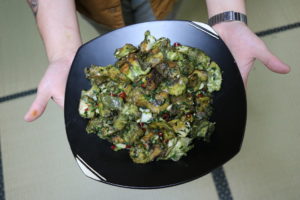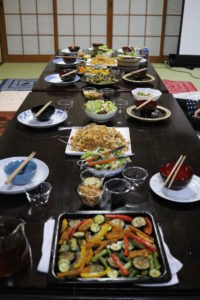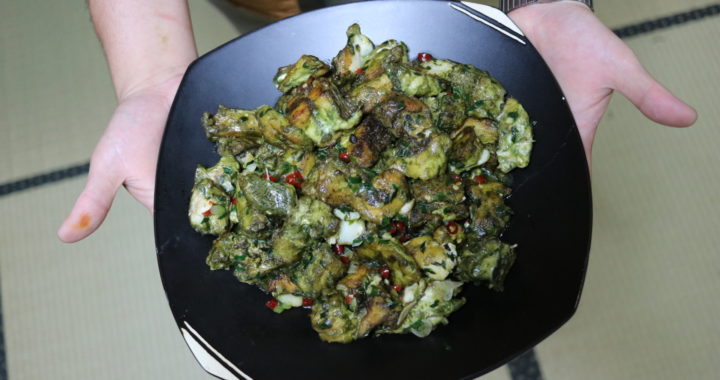1 Fish, 2 Teas
Kai’s Kitchen
Howdy all! We are back at it with more tea cooking, and this week I’ve found something very cool for you all. We are moving on to the later courses of our meal, so time for something a little more filling. We had amuse bouche (appetizer) and we had our soup, so this week we have our fish dish! That’s right, it’s time for the sea and tea to meet in amazing ways. This dish is something I found at the very beginning of my tea cooking studies here at Obubu, and it was too cool for me not to try recreating it. So without further ado, I present… Matcha Fried Fish with Wakocha simmered aromatics! This dish features flaky white fish of your preference, coated then fried with a matcha infused marinade, then tossed in aromatics simmered in Wakocha (Japanese Black Tea). Not only is this dish stunning because of the color the fish takes on, but also from the aroma that it gives off.

So if you read last week’s blog (which I highly recommend) you’d know we talked a bit about Matcha, and the difference between cooking grades and drinking grades of Matcha, but we have another tea stepping into the fray for this dish. Wakocha! What is Wakocha? Wakocha is not a very common tea, in fact most people (including myself) didn’t even know it was a thing. Most, if not all, of the tea production in Japan is green tea, but Wakocha is black tea, (“Wa” meaning Japan, and “Kocha” meaning black tea) which is rather uncommon in Japan. When black tea became popular in Europe, Japan wanted to also try a hand at it, but the flavor was different somehow. Much lighter, Japanese Black Tea never really caught on in Europe or in Japan, so most everybody stopped making it. But here at Obubu Tea Farm, we love the light and floral flavor and aroma that Wakocha gives off. With a dense liquor and notes of honey and chocolate, wakocha is a rich and rejuvenating tea, and one of my personal favorites we grow here in our tea fields.

The history of Black Tea is very interesting. China is the birthplace for Black Tea and can be traced all the way back to the Ming Dynasty. The story goes that tea farmers from Wuyishan were interrupted by soldiers from Jianxi setting up camp in town, disrupting tea production of that day. This delay lead the tea that was drying to oxidize past the normal point, and in an attempt to save it, the tea was then set over a large pine wood fire to quickly get out more moisture. And Ta-da, Black Tea was born! While most people these days call it “Black Tea”, the Chinese call it “Red Tea”; as black tea in China is a famous tea called Pu-Erh, which is another form of heavily oxidized tea. We have Princess Catherine of Braganza to thank for Black Tea popularity in England, as she brought it to England as a dowry after being betrothed to King Charles. Catherine drank it on a daily basis, which was then later copied by other royal ladies as an attempt to be like their queen. With the help of the queen, Black Tea began to be widely considered as a health drink and a drink for the wealthy and upper class aristocrats. With all these components impacting the sales, Black Tea became very profitable, so British traders started buying in mass but were heavily contested by the Dutch, so it became very expensive. This made it too difficult to acquire the amount needed for sale, so traders were then forced to explore other ways to get Black Tea en masse. Britain discovered that India had tea plants which yielded much larger leaves (Sinensis Assamica) compared to that of the Chinese tea plants (Sinensis Sinensis) and due to that, they could bring back much more tea at a more cost-efficient rate.
So with all that said and done, I believe it is time to get into the recipe I’ve made for all of you here today. Let’s go!
Ingredients
2 white fish fillets (fish of you choice, around 300 grams)
1 tbsp Cooking Grade Matcha powder
2 tbsp cornstarch
1 egg white
2 tsp lemon juice
1 tbsp sake
10 grams garlic
5 grams green onion
7 grams red pepper
½ cup pre brewed Wakocha
3 grams sugar
Salt and pepper
Recipe
Take your fish fillets and cut them into bite sized pieces and place into a large bowl. Next add your Cooking Grade Matcha, 1 tsp lemon juice, 1 tbsp of cornstarch, and egg white to the bowl. Add just a pinch of salt and begin mixing until the fish has been entirely coated, cover the bowl, and refrigerate for an hour to set the marinade set.

Brew a cup of delicious Wakocha, let chill in the fridge.
Take you pan and add enough oil to almost submerge your fish and turn on high. After an hour, take your fish out of the fridge and place in the oil a little bit at a time into the hot oil. Fry until golden brown. Take out of oil and place on a plate covered with a paper towel.
When the Wakocha is cold, cut the green onion and red peppers into rings and roughly chop the garlic. Heat a pan over high and liberally coat with oil (but do not fill with oil- we don’t want to create an oil fire when we add the tea), toss in the garlic and fry until get slightly, then add the green onion. When the onions begin to sweat, add the sake, sugar, and the cup of Wakocha you brewed.
Take your fried fish and add it to the Wakocha simmered aromatic and toss. Add the rest of your lemon juice. Make a quick slurry in a small bowl using the rest of you cornstarch and water, and add. Salt and pepper to taste. Serve.

Well friend, that’ll do it for this week. This dish is not too hard to make and extremely satisfying. I love the fact we can work 2 different teas into one dish, and have both come out in flavor to accentuate the flaky delicious white fish. The pepper is hot, but not overwhelming, and garlic and green onion create a lovely warm and toasted aroma. This is a really great addition to our 6 course meal, and leads perfectly into next week’s dish. But more on that next Friday. So until next time, keep drinking spectacular teas and keeping cooking and eating delicious food!

One last thing. I made this dish for our going away party at Obubu, to say goodbye to my Senpai. A few are staying for a bit longer, but my friend, and fellow intern Robin Schmidt, is leaving very soon (by the time this goes up, he’ll have left to go back to Berlin). He taught me so much and happily answered any questions I had, and I wouldn’t have been able to do this without him being here. From brewing me teas I’ve never even heard of, to late nights chatting about games and music; I’ll miss him. So this blog’s dedicated to Robin! Thanks for everything my guy, and good luck with your tea shop; and if you ever need a chef for Komadori Tea, you know who to call.

(Robin and I striking a strong pose)
Kai, Chef, Obubu Intern

